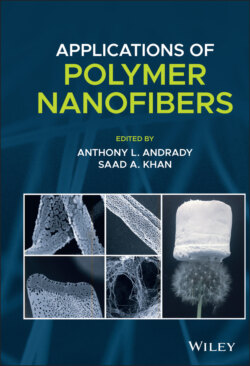Читать книгу Applications of Polymer Nanofibers - Группа авторов - Страница 45
2.4.2 Nanofibrous Woven Fabrics
ОглавлениеBased on the nanofiber yarn formation, nanofiber woven fabrics are also a promising trend, especially for the future textile industry. They have numerous potential applications, including but not limited to artificial leather, filters, wiping cloths, bone tissue engineering, etc. (Zhou and Gong 2008). Nanofiber fabrics with plain‐woven structures have been achieved in recent years.
Shao et al. wove a scaffold from nanofiber yarns of blended PLA and tussah silk fibroin (TSF) to achieve good biocompatibility (Figure 2.14) (Shao et al. 2016). First, nanofiber yarns were obtained by electrospinning and winding processes. Then, the warp and weft nanofiber yarns were interwoven vertically into a single‐layer woven fabric, three layers of which were then jointed into a three‐dimensional (3D) woven structure. This 3D woven structure demonstrated excellent mechanical properties (Young's modulus of 417.65 MPa and tensile strength of 180.36 MPa). In the structure, warp, and weft densities were 300 root/10 cm and 500 root/10 cm, respectively, the entire thickness was 2.0 ± 0.1 mm. Because of the use of PLA and TSF, this structure also exhibited biomimetic architecture and good biocompatibility.
Zhao et al. applied AgNPs nanofiber yarns into a 3D woven structure by the process shown in Figure 2.15 (Zhao et al. 2017). Nylon‐6,6 yarns were placed on the collecting drum. The precursor containing AgNPs and 8 wt% of PAN was then electrospun onto nylon‐6,6 yarns. Subsequently, nylon‐6,6 monofilament was used as warp yarn and Z yarn, and nylon‐6,6 draw textured yarn with silver ion as the weft yarn to make 3D woven filters. Antibacterial testing was also carried out by incubating the obtained 3D woven structure in the Staphylococcus aureus cultural gelation for 24 hours. It was observed that there was blank space around the AgNPs nanofiber‐contained 3D woven structure, indicating the antimicrobial property of the product was ideal for the application of wastewater filtration.
Figure 2.14 (a) Photograph of PLA/TSF nanofiber woven fabric; SEM images of (b) the surface of the fabric, (c) cross section of the fabric, and (d) cross section of the yarns in the fabric.
Source: Reproduced with permission from Shao et al. (2016). Copyright 2016, Elsevier.
Figure 2.15 Illustration of the fabrication process for the 3D woven fabric filter with AgNPs/PAN nanofiber wrapped yarns.
Source: Reproduced with permission from Zhao et al. (2017). Copyright 2017, Elsevier.
Figure 2.16 (a) The weaving of the electrospun nanofibers in succession (from 1 to 4), (b) Schematic image of the overall deposition pattern.
Source: An et al. (2016).
(c, d) SEM images of the deposited PAN fibers.
Source: Reproduced with permission from An et al. (2016). Copyright 2016, Elsevier.
Interestingly, a single nanofiber can also be fabricated into the form of a woven‐like structure. In Figure 2.16, An et al. arranged electrospun nanofibers with the orthogonal direction in virtue of intelligent control (An et al. 2016). It was by means of giving electrical drive to the charged polymer jets, which led to the bending and looping of the jets.
There are also many hybrid nanofibers with conventional fiber fabrics for combining mutual advantages. Bagherzadeh et al. produced a multilayered fabric with PU nanofibers layered into a sandwich of woven fabric for use as a breathable barrier textile material (Wang et al. 2016). The resultant fabric displayed low air permeability that resulted from small pore sizes but presented good water vapor permeability (Bagherzadeh et al. 2011). Wang et al. used sandwiched polyimide nanofiber/carbon woven fabric for capturing PM 2.5 particles. The maximum air filtration efficiency reached 99.99%.
